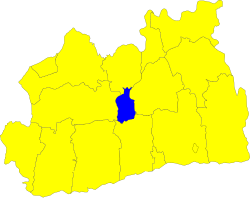Effingham Half-Hundred: Difference between revisions
Created page with "right|thumb|250px|The Hundred or Half-Hundred of Effingham in Surrey The '''Effingham Hundred''' or '''Effingham Half-Hundred''' is a h..." |
No edit summary |
||
| (One intermediate revision by the same user not shown) | |||
| Line 1: | Line 1: | ||
[[File:Effingham Hundred - Surrey.svg|right|thumb|250px|The Hundred or Half-Hundred of Effingham in Surrey]] | [[File:Effingham Hundred - Surrey.svg|right|thumb|250px|The Hundred or Half-Hundred of Effingham in Surrey]] | ||
The '''Effingham Hundred''' or '''Effingham Half-Hundred''' is a hundred of [[Surrey]], ambiguous as to whether it be treated as a hundred in its own right or as a half-hundred, and if the latter then grouped with [[Copthorne Hundred]] to the east and north-east. Effingham on its own terms is the smallest hundred in [[Surrey]]. | The '''Effingham Hundred''' or '''Effingham Half-Hundred''' is a hundred of [[Surrey]], ambiguous as to whether it be treated as a hundred in its own right or as a half-hundred, and if the latter then grouped with [[Copthorne Hundred]] to the east and north-east. Effingham on its own terms is the smallest hundred in [[Surrey]], in both area and population, the latter being 13,544 in 2011. | ||
The Half-Hundred is in the centre of the county and comprises the ancient parishes of: | The Half-Hundred is in the centre of the county and comprises the ancient parishes of: | ||
| Line 8: | Line 8: | ||
==History== | ==History== | ||
From a date before the Tudor period | From a date before the Tudor period Effingham was connected with [[Copthorne Hundred]], and so was styled and treated as the Half-hundred of Effingham.<ref>{{cite book |url=http://books.google.co.uk/books?id=ULcHAAAAQAAJ&pg=PA337&lpg=PA337#v=onepage&q&f=false |title=A topographical history of Surrey|author=E.W. Brayley |pages=337–338 |publisher=Tilt and Bogue|year=1841|accessdate=30 April 2012}}</ref> It contains the smallest amount of land in Surrey, at 47 to 50 hides.<ref name=m>{{brithist|42974|The hundred of Effingham: Introduction and map}} – {{VCH|Surrey|vol=3}}</ref> | ||
In the [[Domesday Book]] of 1086, Effingham Hundred included the above and two unknown settlements of ''Driteham'' and ''Pechingeorde''.<ref name=m/> | In the [[Domesday Book]] of 1086, Effingham Hundred included the above and two unknown settlements of ''Driteham'' and ''Pechingeorde''.<ref name=m/> | ||
| Line 14: | Line 14: | ||
It was a royal hundred, and in a document of the reign of Edward I is stated to have been farmed by all its various owners altogether formerly for half a mark per annum, but then for 10 shillings. | It was a royal hundred, and in a document of the reign of Edward I is stated to have been farmed by all its various owners altogether formerly for half a mark per annum, but then for 10 shillings. | ||
In minor civil dispute settlement, in 1628 the Borough of [[Kingston upon Thames|Kingston]] received a grant of jurisdiction within the "hundred of Copthorne and Effingham" in compensation for their loss of the privilege of court leet in Richmond and Petersham and this grant was confirmed by Charles I to in 1638, and as the last vestige of the hundred's influence held good until late 19th century | In minor civil dispute settlement, in 1628 the Borough of [[Kingston upon Thames|Kingston]] received a grant of jurisdiction within the "hundred of Copthorne and Effingham" in compensation for their loss of the privilege of court leet in Richmond and Petersham and this grant was confirmed by Charles I to in 1638, and as the last vestige of the hundred's influence held good until late 19th century reform of municipal corporations. | ||
==References== | ==References== | ||
{{reflist}} | {{reflist}} | ||
{{Surrey hundreds}} | |||
Latest revision as of 16:48, 5 January 2019

The Effingham Hundred or Effingham Half-Hundred is a hundred of Surrey, ambiguous as to whether it be treated as a hundred in its own right or as a half-hundred, and if the latter then grouped with Copthorne Hundred to the east and north-east. Effingham on its own terms is the smallest hundred in Surrey, in both area and population, the latter being 13,544 in 2011.
The Half-Hundred is in the centre of the county and comprises the ancient parishes of:
History
From a date before the Tudor period Effingham was connected with Copthorne Hundred, and so was styled and treated as the Half-hundred of Effingham.[1] It contains the smallest amount of land in Surrey, at 47 to 50 hides.[2]
In the Domesday Book of 1086, Effingham Hundred included the above and two unknown settlements of Driteham and Pechingeorde.[2]
It was a royal hundred, and in a document of the reign of Edward I is stated to have been farmed by all its various owners altogether formerly for half a mark per annum, but then for 10 shillings.
In minor civil dispute settlement, in 1628 the Borough of Kingston received a grant of jurisdiction within the "hundred of Copthorne and Effingham" in compensation for their loss of the privilege of court leet in Richmond and Petersham and this grant was confirmed by Charles I to in 1638, and as the last vestige of the hundred's influence held good until late 19th century reform of municipal corporations.
References
- ↑ E.W. Brayley (1841). A topographical history of Surrey. Tilt and Bogue. pp. 337–338. http://books.google.co.uk/books?id=ULcHAAAAQAAJ&pg=PA337&lpg=PA337#v=onepage&q&f=false. Retrieved 30 April 2012.
- ↑ 2.0 2.1 The hundred of Effingham: Introduction and map – A History of the County of Surrey - Volume : {{{2}}} (Victoria County History)
| Hundreds of Surrey |
|---|
|
Blackheath • Brixton • Copthorne • Effingham (half) • Elmbridge • Farnham • Godalming • Godley • Kingston • Reigate • Tandridge • Wallington • Woking • Wotton |